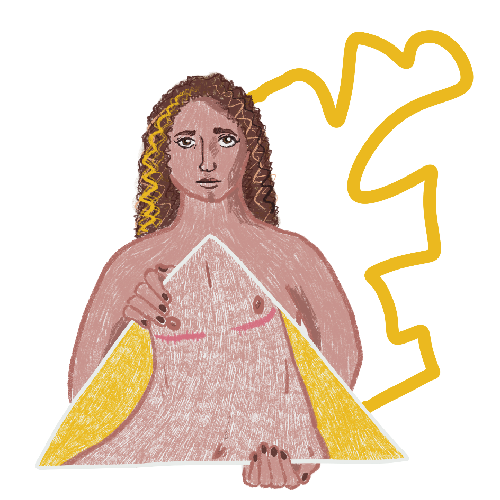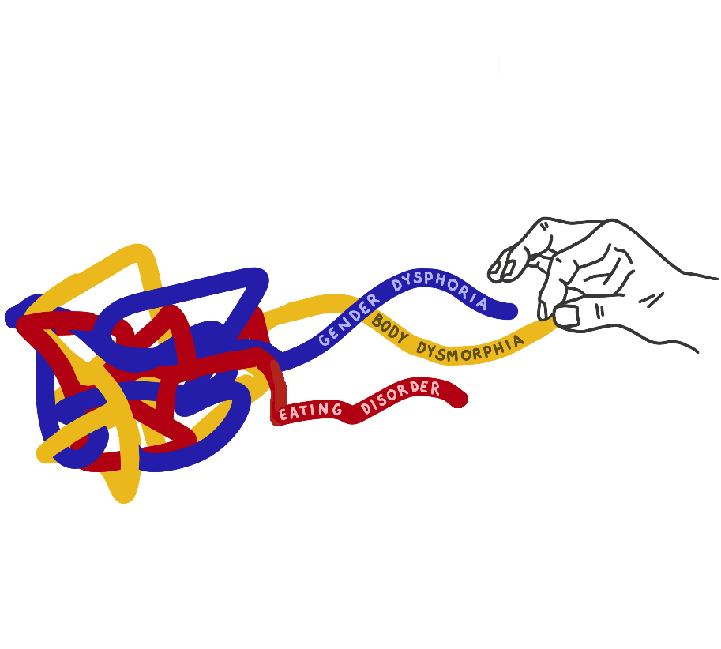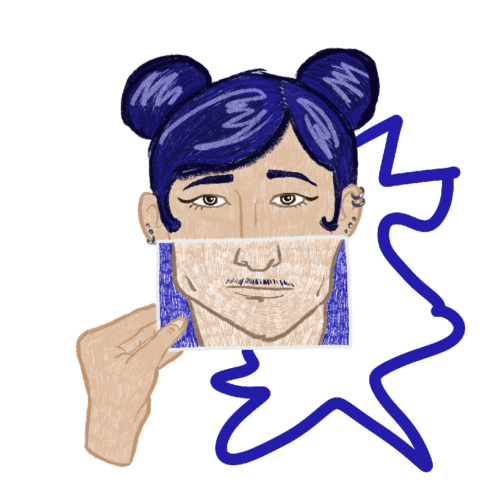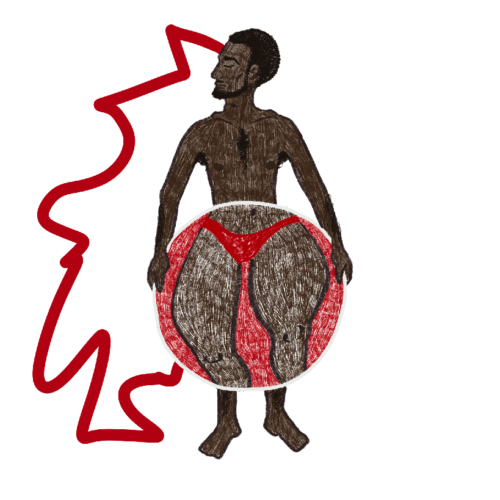
My Body isn’t Mine
Image: Jan Broekhuizen
The correlation between body dysmorphia, gender dysphoria, and an eating disorder
I have a love-hate relationship with my body, which, I think, is something a lot of people will recognise, but especially trans people. The hate I have for my body is indeed caused in part by the gender dysphoria I feel; I hate my wide hips and big thighs, my chest, the soft roundness of my face. Some days I hate everything about my body, just because it doesn’t feel like it belongs to me. It’s like I’ve temporarily rented a car and they gave me a wrecked, out-of-date edition by accident. Not, to compare my body to a commodity of course, but you get the point. However, there is also a big part of my body that I hate because I was conditioned to hate it: everything about my body that looks fat. My thighs, my stomach, my arms. As a kid I learned that fatness equals ugly, that I should hate those parts of me that didn’t fit into contemporary body ideals. Anyone like me who was raised in the early ‘00s knows that those ‘aspire-to-be-a-stick’ beauty standards were killing. So, once I entered puberty, I started gaining weight and my thighs, hips and chest got bigger. I hated it. I obsessed over them. I starved myself and for years was convinced that the only way to fit into this world was by shrinking myself as much as possible. I never thought beyond that because I never had any reason to; I had internalised the damaging messages of diet-culture by which I was, and am still, surrounded.
But then I healed my relationship with food and worked on my internalised fatphobia. I started by just appreciating my body for keeping me alive at first, and from there I slowly learned how to love it. I moved from simply treating my body as a machine that required maintenance to keep myself alive, towards understanding how to radically love my body for everything it is — for all its fat, dips, and hair, — instead of hating it for everything I was taught it shouldn’t be. It was, and still is, a hard process, and I’m not always good at it. During puberty I had developed body dysmorphia*, which convinced me that, despite the weight I had lost, my hips and thighs were still “disgustingly” big. It didn’t matter if other people told me they weren’t, I couldn’t see it. My mind disfigured the reflection in the mirror until all I could see was an exaggeration of my thighs and hips. I had always ascribed that hate for those parts of my body to my body dysmorphia and the eating disorder because I was taught, as everyone is, that fatness of any kind is bad. But then the disgust I felt for my hips and thighs and those “feminine” parts of my body didn’t go away, even though I no longer hated my body for having fat. At some point through therapy I realised I had been going through life dissociated because every time I tried to consciously be in my body, I felt awful and I couldn’t understand why. It didn’t matter, right? It’s a beautiful body, for a woman, I’d think. It just wasn’t mine.
That’s when it clicked: my body is supposed to feel like mine and it doesn’t. Despite all the work I had been putting into healing my relationship with my body, the years of body dysmorphia and internalised fatphobia hid that what I truly hated deep down was that it was perceived as a woman’s body. I didn’t want to be seen like that. It took me years to realise that because I thought you were supposed to hate your body. I grew up surrounded by people (mostly women, you know what society is like) who hated their bodies. It’s not right, you’re not supposed to hate it or to hate yourself like that. Your body is a part of you and it deserves to be treated well and be loved, unconditionally. But that can be incredibly hard to do when you’ve both been conditioned by society to hate your body and you’re assigned the wrong gender. That’s where I think the important difference between body dysmorphia and gender dysphoria lies: the former comes from outside, the latter from within. No child just hates, feels shame, and is disgusted by parts of their body without being taught to. As comedian Hannah Gatsby said, “self-hatred is only ever a seed planted from outside in”. This, you can unlearn. Ask yourself, why do I hate my nose, my stomach, my teeth? Is it something I was continuously, implicitly or explicitly, told was ugly or wrong with me? From there work on your relationship with that aspect of your body, on your own or through therapy. You are the only one who sees that part as flawed, to whom it becomes the central focus of your appearance whenever you look at yourself. It is not something that other people, generally, will notice about you, despite it being something that has become so exaggerated and warped in your mind that it is all you see.
However, you aren’t conditioned to be trans. If you’re trans and experience gender dysphoria, you grow up in a body and are assigned a gender, but despite what everyone else says and sees, how you feel inside doesn’t match up. No one taught you that. In fact, they’ll often do everything in their power to make you believe you do feel like your assigned gender. With body dysmorphia, the reflection I see in the mirror is wrong because my mind hyperfocuses and exaggerates the parts I hate. I actually see a distorted image. I don’t look in the mirror and see a body with a dick and no tits, to put it harsh binary terms, no matter how much I would like to look like that and feel like I should have looked like that. That is the difference. You can unlearn and heal from body dysmorphia, because it was self-hatred taught to you by your environment. You cannot unlearn gender dysphoria because it is caused by an incongruence between your gender identity and assigned gender. Gender dysphoria can, mostly, go away once you are free to express yourself how you actually feel and when you can perform your actual gender identity, but your transness doesn’t disappear with it.
As I said before, all of this can be incredibly hard to figure out when you experience both body dysmorphia, developed an eating disorder, and experience gender dysphoria. And I know I’m not alone in this. After posting the reader’s call, a bunch of wonderful trans people reached out to TRANS magazine to share their story. I interviewed three of them to show the rest of you, dear readers, that you are not alone and that it really does get better.
For the interview, I talked to Asa, Kronos*, and Jack about their experiences with body dysmorphia, eating disorders, and gender dysphoria. I am incredibly thankful for their openness and honesty and I hope you find as much recognition, confirmation, and hope in their stories as I did. If you want to work on your own body issues but don’t know where to start, Asa recommended “The Body Is not an Apology” by Sonya Renee Taylor, which is a wonderful book to help you on your journey to dismantle internalised fatphobia and rebuild a healthy relationship with your body.

What does your body dysmorphia, or your relationship with your body look like for you?
Kronos*: “My body dysmorphia is mainly focused on the sexualized ‘stereotypically feminine’ aspects of my body: this includes my wide hips, my chest (breasts), and getting my period. I realized recently that my hips are not something I can change as it is my structure, so no matter how skinny I get, I will have wide hips. That’s why I’ve decided to work on buffing up my upper body so that it takes over my wide hips and perhaps will help get me more euphoric moments. I also have body dysmorphia towards my tummy area due to fatphobia. When I was a young teenager, I used to workout my abs every night before sleep, it was an obsession. I recall as well, when I used to go to sleep, I used to press a pillow or a teddy bear against my tummy to make sure it is not relaxed so that it would stay flatter. My body dysmorphia is a main trigger to my eating habits. Currently I am at a much better place as I’m aware of it, but it is still a struggle every day.”
Jack: “My body dysmorphia manifests overall as a complete disconnect of my mind and body. I don’t experience my body as myself at all, and I have trouble reconciling with the fact that there is only so much I can do to even approach who I know I am on the outside. My body dysmorphia made me very lonely and made me feel like I was a freak, not belonging anywhere because I couldn’t relate to anyone in my surroundings. As a result, I have had trouble with self-harm in different ways, I tend to punish my body for my emotional distress”
Asa: “I did not suffer from body dysmorphia at all as a young child. From when I was about 12, I started perceiving the relationship with my body through the eyes of others, as I received compliments on the way I looked. Deep inside, though, I wanted my body to look different although I did not know how. Wearing corsets was one of the ways I tried to alter my shape, but until today I can still feel the negative impact of that. It didn’t just alter my body, but especially ruined my breathing.
Around the time I was 21 my body dysmorphia was at its worst. I was discovering my gender identity, looking for ways to express that and formed a relationship with my body through the eyes of a camera by taking many ‘selfies’. So one way was, well… taking pictures, the other way was exercising. I was putting so much effort into changing it, documenting the process every day, but the relationship with my body grew very much askew. The harder I worked out and changed my diet, the more I felt like a failure.
At the moment my body dysmorphia is cured and yoga was one of the things that improved the relationship with my body. The importance of yoga in loving myself – however cheesy that sounds – led to me founding Be Queerful as the first queer yoga school in Europe”
Do you remember when it started?
Jack: “I’ve been hyperfocused on my body my whole life, because it’s never been ‘right’. Even as a small child, I always felt like I was a different species from my peers. But instead of embracing the things that were comfortable to me, I was desperately trying to fit myself into a prescribed mould. Before realizing that I was trans, I was still trying to double down on presenting feminine, because that felt like the only (relatively) socially acceptable option since I was always overweight. I always disliked how broad my chest and shoulders were. Obviously, I didn’t like anything on my body, but I felt like the shoulders, broad chest, small breasts, and strong arms would always prevent me from being ‘normal’, no matter how hard I tried. Conversely, when I started figuring out my identity, it was the exact opposite: I was never masculine enough, and I would resort to starving myself in order to gain a semblance of control of my body and how it behaved”
Asa: “As a teenager I often said that I wanted to change the way my body looked, but that I did not know why. Later as a student I learned why, but also learned —the hard way— that physical change was not going to bring me happiness.”
Kronos*: “My tummy dysmorphia started at a young age, I think I was around 9 or 10. This was mainly induced by fatphobia around me from relatives, sadly. My body dysmorphia related to gender. I think I never liked that I looked ‘feminine’ but couldn’t pinpoint what it was exactly until I came out to myself as a lesbian when I was 18. That is when things started clearing up and making sense. Other than realizing and understanding that it is possible for me to be a lesbian and to love and be attracted to women, I also started looking back to me as a child and noticing signs. I recall wanting to be a man to be able to hit on and love a woman. So during and a few years after my coming out, I thought deep down that I wanted to be a man and to transition fully, but at the same time I had my doubts as I also felt comfortable being myself as a tomboy and androgynous person who is a lesbian. I think it is important to point out here that I lived in a country where homosexuality is a crime,the UAE, where society is extremely homophobic unless you find your safe circle. So this added societal and familial pressure enhanced the idea of transitioning to a man so my attraction to women would be ‘normal’.”

When and how did you realise you were trans?
Asa: “I got into the art academy when I was around 17, and that’s when food and weight and everything started to sort of cloud my mind. Besides a need to lose weight, it became a bit of a means of stress-management because I was totally stressed in the art academy. It was also a time where I started to develop and discover stuff about gender, my own gender identity. The book Kafka on the Shore by Haruki Murakami has been for me the ‘aha’ moment of ‘hey, maybe I am not a cisgender female, maybe I’m something more’, because there’s a trans character in there. They’re not even explicitly called trans, they’re just a person and a very lovely character. They’renot even a protagonist or anything, but it really hit home for me when I was reading it. And from there, I started my own gender exploration and discovery.”
Jack: “I was never exposed to trans people and their experiences during my life. Where I come from, the LGBT+ community was scarce and the rule was: assume everyone is homophobic (or queerphobic) unless proven otherwise. I had no idea HRT (hormone replacement therapy) was even a thing until very late in my life. I’m ashamed to admit that, for the longest time, I didn’t allow myself to even think of being a trans man as a possibility because I genuinely thought it meant putting on a baseball cap and ‘boys-don’t-cry’-it. That was simply not an option for me. I was in my early 20s when I was confronted with actual trans people for the first time, especially online via YouTube. I knew I was trans, but it took a couple more years of denial and bargaining until I accepted and embraced it.”
Kronos*: “I recently came out as nonbinary. It was early this year (2021) that I started sharing it with my close friends and people around me. I got exposed to what nonbinary meant two years ago or so, but that challenged my inner thoughts and feelings in a way that felt so comfortable. It just made sense to me that I don’t fully identify with either of the binary genders, and it became clear in my head that I don’t necessarily want to transition to be a man. I want to be myself and that is a combination of the binary, yet outside the binary at the same time. By saying it out loud, it made me feel immediately as though the people now see me the way I want them to see me. Even though I am still Kronos* to my friends, something clicked and changed for me where I felt they see me through the same lens as I do. This made me feel so much love and acceptance for myself.”

Do you experience gender dysphoria? What things make you dysphoric?
Jack: “I used to think that my disconnect with my body was a result of only the eating disorder. It wasn’t until I lost so much weight and was borderline emaciated that I understood it wasn’t about weight as much as it was about the fact that I don’t identify with my ‘feminine’ body at all. I never felt more at ease with myself than when I was allowed to be entirely androgynous or masculine. I feel especially dysphoric when I gain weight on my hips, thighs, and butt. I used to enjoy make-up, but now I don’t feel masculine enough yet to be able to wear it. Same goes for wearing high heels, crop tops, anything that is socially coded as feminine. I do want to dye my hair and wear nail polish and even make up sometimes, and I do want to wear whatever it is I fancy, but I want to be able to do it while still clearly looking like a man.”
Kronos*: “Since I was a kid, I never felt comfortable with my assigned gender. As you can tell from the stories shared above, I used to aspire and to wish to be a boy as I related to that binary stereotype more than my assigned gender. Later on in life, my gender dysphoria stayed with me and was a mix of physical aspects and stereotypical societal expectations rooted in gender roles. I think I felt gender euphoria when I came out as nonbinary recently. In addition, I find it euphoric being topless in public without being sexualized.”
Anything else you’d like to share?
Asa: “‘It’s a weird thing if you’re in transition or you’ve begun your journey of gender discovery. Most people assume that you have this road and you go from point ‘a’ to point ‘b’. And when you reach ‘b’ you don’t have to look back at ‘a’ anymore; you can just forget about it or you think that people, to a certain extent , are not interested in hearing about ‘b’ because they’re still at ‘a’ struggling. But I think you need some positivity as well. Believing in something positive really helps to internalise it instead of only hearing negative stories. Another really big thing for me was to set these dreams, these goals. That also helps you to get through. The journey to feeling good in your own skin is different for everyone, but I hope by telling this story I can inspire some of you and show that you can overcome body dysmorphia.”
Kronos*: “One of my biggest struggles right now with my body dysmorphia is my chest. I hate the fact that the female chest is so sexualized while the male chest is not. I am trying hard to rid myself of what society taught me: that I cannot be topless in public because my chest is sexual. But it is so difficult. I feel this is so difficult not only because I am being sexualized, but also because I am being sexualized within a gender binary. Excuse my language, but it’s very fucked up. This is my story in a nutshell so far, and I am still evolving and trying to unlearn things taught to me while learning things to find myself, the self I lost while growing up when society pushed its binary and heteronormative agenda on me.”
1 From Hannah Gatsby’s “Nanette”.
